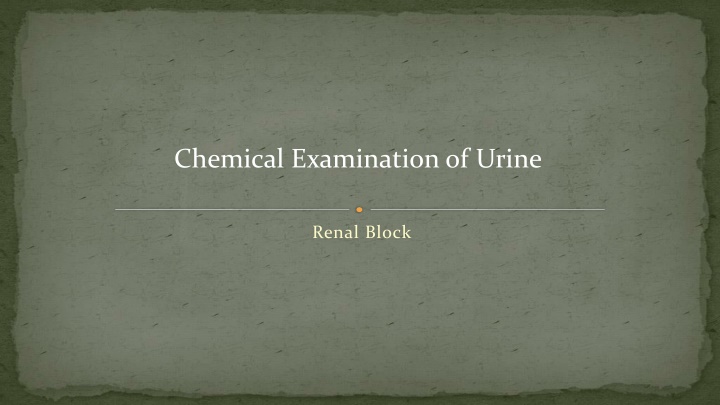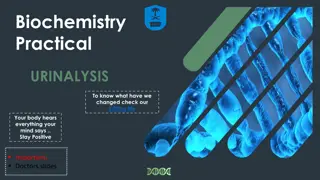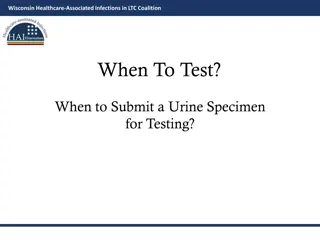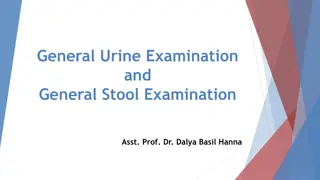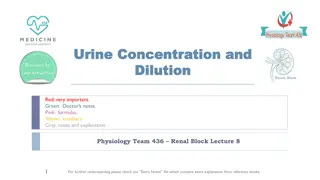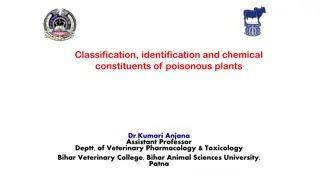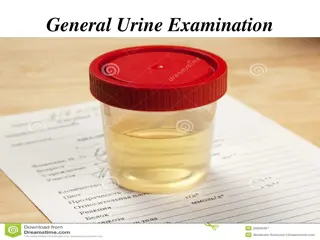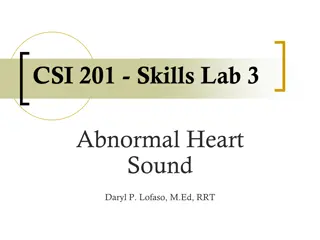Chemical Examination of Urine: Differentiating Normal vs. Abnormal Constituents
This lecture covers the composition of urine, including proteins, sugars, ketone bodies, nitrite, and more. It explains proteinuria types and discusses conditions like fructosuria and hematuria. Learn about the kidneys' role in urine formation and the significance of abnormal urine constituents.
Download Presentation

Please find below an Image/Link to download the presentation.
The content on the website is provided AS IS for your information and personal use only. It may not be sold, licensed, or shared on other websites without obtaining consent from the author.If you encounter any issues during the download, it is possible that the publisher has removed the file from their server.
You are allowed to download the files provided on this website for personal or commercial use, subject to the condition that they are used lawfully. All files are the property of their respective owners.
The content on the website is provided AS IS for your information and personal use only. It may not be sold, licensed, or shared on other websites without obtaining consent from the author.
E N D
Presentation Transcript
Chemical Examination of Urine Renal Block
Objectives Upon completion of this lecture, students should be able to: Differentiate between normal and abnormal constituents of urine including: Proteins, sugars, ketone bodies, nitrite, bile pigments, blood etc. Know the clinical conditions in different types of proteinuria, blood-uria and glycosuria etc.
Overview Introduction Normal composition of urine Abnormal composition of urine Proteinuria: Pre-renal (multiple myeloma) Renal Post-renal Glycosuria: fructosuria, galactosuria Ketonuria Hematuria: hemoglobinuria
Urine Urine is a fluid excreted by most animals including humans It is formed in the kidneys (renal glomeruli) The fluid undergoes chemical changes before it is excreted as urine Normal urine excretion by a healthy person is about 1.5 L per day
Normal composition of urine Urine contains organic and inorganic constituents: Major inorganic constituents: Sodium Potassium Chloride Small amounts of Ca, Mg, sulfur and phosphates Traces of Fe, Cu, Zn, I Major organic constituents: Non-protein nitrogen (NPN) compounds Organic acids Sugars Traces of proteins, vitamins, hormones, pigments
Abnormal composition of urine Proteins: Normal urine contains small amount of protein: < 200 mg/day Excretion of more than this level causes proteinuria Proteinuria: Excretion of abnormal amounts of protein in urine Proteinuria has three types: Pre-renal Renal Post-renal
Pre-renal proteinuria Some diseases or conditions increase plasma protein levels not involving the kidneys Causes increased filtration of these proteins in the kidneys This exceeds the normal reabsorptive capacity of renal tubules Results in overflow of proteins in the urine Multiple myeloma: Cancer of the antibody-producing plasma cells Causes pre-renal proteinuria
Pre-renal proteinuria The serum contains elevated levels of light-chain monoclonal antibodies called Bence-Jones protein This protein is filtered in the kidneys in high amounts Exceeding the tubular reabsorption capacity Hence excreted in the urine Bence-Jones protein coagulates at 40 60 oC and dissolves at 100 oC Multiple myeloma cases are diagnosed by: Serum electrophoresis Immunoelectrophoresis
A: Normal serum B: Multiple myeloma (M component in region) C: Densitometry of A D: Densitometry of B (M component is called M Spike)
Multiple myeloma A: Serum protein electrophoresis showing the M component B: Serum and urine immunofixation electrophoresis
Renal proteinuria Associated with renal disease Glomerular proteinuria: High glomerular permeability causes filtration of high molecular weight proteins Example: glomerulonephritis Tubular proteinuria: Low tubular reabsorption with normal glomerular permeability Causes excretion of low mol. wt. proteins Example: chronic nephritis
Renal proteinuria Orthostatic (postural) proteinuria: A form of benign or physiological proteinuria Occurs frequently in young adults due to periods spent in a vertical posture (body position) or during muscular exercise Increased pressure on the renal vein in the vertical position causes orthostatic proteinuria Disappears in horizontal posture
Renal proteinuria Microalbuminuria: Presence of small amounts of albumin in the urine 20 200 mg/L Cannot be detected by ordinary urine testing Needs special tests for detection Early indicator of glomerular dysfunction due to: Uncontrolled diabetes mellitus Hypertension
Post-renal proteinuria Proteins are added to the urine after kidney filtration While passing through the lower urinary tract (ureters, bladder, urethra, prostate, vagina) Due to: Lower urinary tract infection Trauma Tumors Stones
Glycosuria Presence of sugar in urine Glucosuria: Presence of detectable amount of glucose in urine Due to diabetes mellitus Plasma glucose level exceeds the renal threshold Due to renal disease (renal glucosuria) Normal plasma glucose level with proximal tubular malfunction Decreased renal threshold as observed in gestational diabetes and Fanconi s syndrome
Glycosuria Fructosuria: Presence of fructose in urine Nutritional cause: High fructose intake Metabolic cause: Low fructokinase or aldolase B in the liver Galactosuria: Presence of galactose in urine Nutritional cause: high galactose intake Metabolic cause: Low galactokinase or galactose -1-PO4 uridyl transferase in the liver
Ketonuria Presence of ketones, acetone, acetoacetic acid and - hydroxybutyric acid in urine Due to: Diabetic ketoacidosis Starvation Dietary imbalance: high fat and low CHO diet Phenylketonuria (PKU)
Choluria Presence of bile, bilirubin and bile salts in urine Bilirubin: normally no bilirubin is detected in urine It is detected in: Hepatocellular damage Obstruction of bile duct due to stones (extrahepatic) and hepatic tumors (intrahepatic) Urobilinogen: normally present in trace amounts High urobilinogen is found in: Hemolytic anemia Hepatocellular damage Nitrites: Positive nitrite test indicates bacteria in urine
Hematuria Presence of detectable amount of blood in urine Due to: Acute / chronic glomerulonephritis Local disorders of kidney and genito-urinary tract Trauma, cystitis, renal calculi, tumors Bleeding disorders Hemophilia
Hematuria Hemoglobinuria: Presence of hemolysed blood in urine Due to: Hemoglobinopathies Sickle cell anemia Thalassemia Malaria Transfusion reaction Blood group incompatibility
